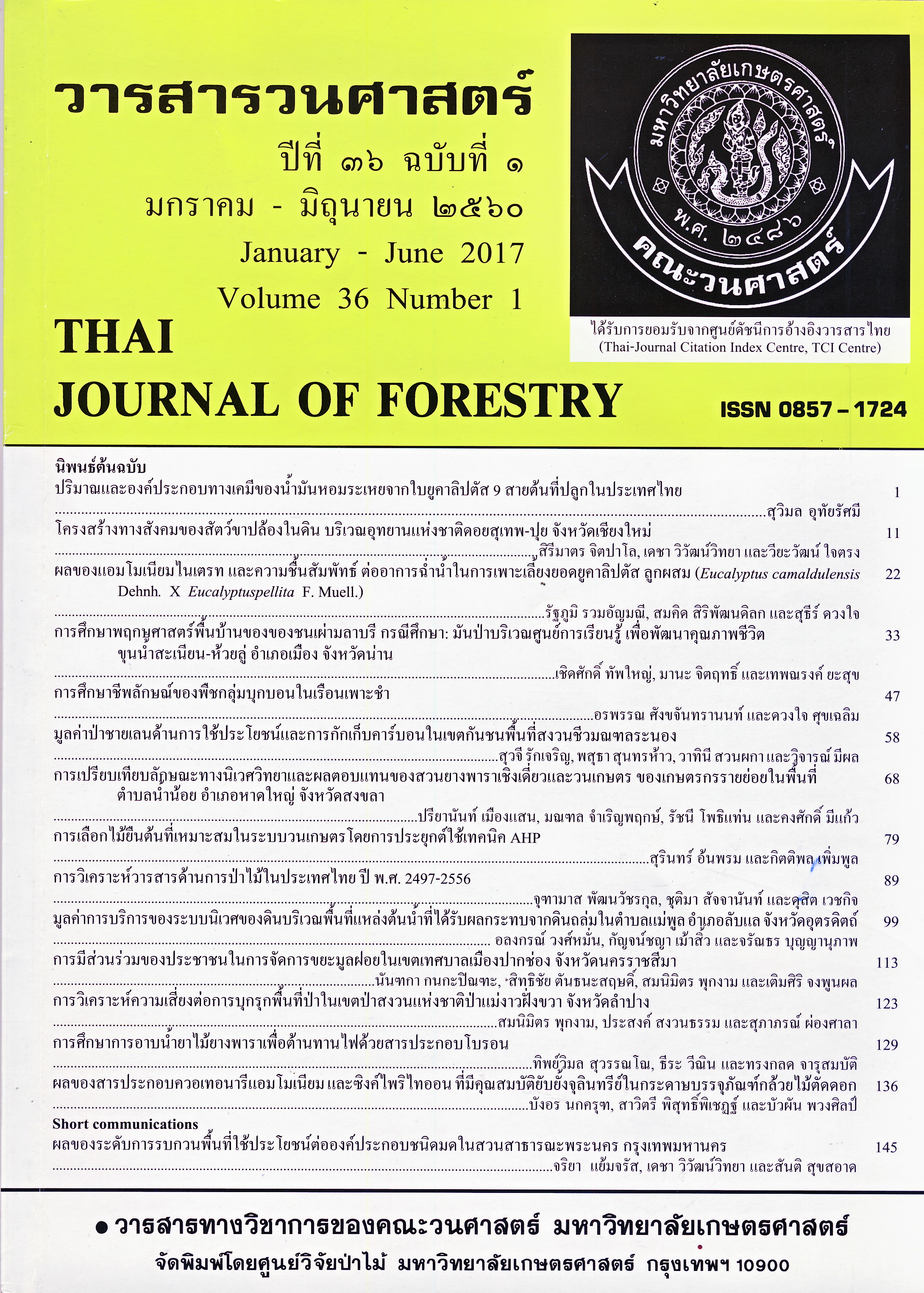ปริมาณและองค์ประกอบทางเคมีของน้ำมันหอมระเหยจากใบยูคาลิปตัส 9 สายต้น ที่ปลูกในประเทศไทย
Main Article Content
บทคัดย่อ
การศึกษาครั้งนี้มีวัตถุประสงค์เพื่อศึกษาปริมาณและองค์ประกอบทางเคมีของน้ำมันหอมระเหยที่สกัดได้จากใบยูคาลิปตัสจำนวน 9 สายต้นที่ปลูกในประเทศไทย ได้แก่ สายต้น S1, K83 (ลูกผสมข้ามชนิดระหว่าง Eucalyptus camaldulensis และ E.pellita) S2 (ชนิด E.camaldulensis) S3, S4, S5 (ลูกผสมข้ามชนิดระหว่าง E.camaldulensis และ E.urophylla) G2 (ลูกผสมข้ามชนิดระหว่าง E.camaldulensis และ E.grandis) K7 (ลูกผสมข้ามชนิดระหว่าง E.camaldulensis และ E.deglupta) และ K58 (ชนิด E.urophylla) โดยทำการเก็บตัวอย่างใบจากต้นอายุ 4 ปี ในจังหวัดกาญจนบุรี จากนั้นนำไปสกัดน้ำมันหอมระเหยด้วยวิธีการกลั่นโดยใช้น้ำ และศึกษาองค์ประกอบทางเคมีด้วยเครื่อง Gas Chromatograph-Mass Spectrometer (GC-MS) ผลการศึกษาพบว่า ยูคาลิปตัสทั้ง 9 สายต้นให้ปริมาณน้ำมันหอมระเหยแตกต่างกันอย่างมีนัยสำคัญทางสถิติ (P<0.05) โดยมีปริมาณอยู่ระหว่าง 0.54-2.37% (ปริมาตรต่อน้ำหนักอบแห้ง) สายต้นที่ให้ปริมาณน้ำมันหอมระเหยมากที่สุดคือ สายต้น S2 และ K83 (2.37 และ 2.36%) รองลงมาได้แก่ สายต้น S1 (2.14%) และ K58 (1.70%) ตามลำดับ ส่วนผลการวิเคราะห์องค์ประกอบทางเคมีในน้ำมันหอมระเหย พบสาร 1,8-Cineole (Eucalyptol) เป็นสารหลักในน้ำมันหอมระเหยในเกือบทุกสายต้น ซึ่งสารนี้เป็นสารที่มีการนำมาใช้ประโยชน์ในทางยา โดยสายต้นที่มีปริมาณสาร 1,8-Cineole มากที่สุด ได้แก่ สายต้น S2 (67.22%) รองลงมาได้แก่ สายต้น K58 (60.70%) ผลจากการศึกษาครั้งนี้เสนอแนะได้ว่า สายต้น S2 น่าจะมีศักยภาพในการนำใบไปกลั่นน้ำมันหอมระเหยเพื่อการใช้ประโยชน์ในทางยามากที่สุด
Downloads
Article Details
ข้าพเจ้าและผู้เขียนร่วม (ถ้ามี) ขอรับรองว่า ต้นฉบับที่เสนอมานี้ยังไม่เคยได้รับการตีพิมพ์และไม่ได้อยู่ในระหว่างกระบวนการพิจารณาตีพิมพ์ลงในวารสารหรือสิ่งตีพิมพ์อื่นใด ข้าพเจ้าและผู้เขียนร่วม (ถ้ามี) ยอมรับหลักเกณฑ์และเงื่อนไขการพิจารณาต้นฉบับ ทั้งยินยอมให้กองบรรณาธิการมีสิทธิ์พิจารณาและตรวจแก้ต้นฉบับได้ตามที่เห็นสมควร พร้อมนี้ขอมอบลิขสิทธิ์ผลงานที่ได้รับการตีพิมพ์ให้แก่วารสารวนศาสตร์ คณะวนศาสตร์ มหาวิทยาลัยเกษตรศาสตร์ กรณีมีการฟ้องร้องเรื่องการละเมิดลิขสิทธิ์เกี่ยวกับภาพ กราฟ ข้อความส่วนใดส่วนหนึ่ง หรือ ข้อคิดเห็นที่ปรากฏในผลงาน ให้เป็นความรับผิดชอบของข้าพเจ้าและผู้เขียนร่วม (ถ้ามี) แต่เพียงฝ่ายเดียว และหากข้าพเจ้าและผู้เขียนร่วม (ถ้ามี) ประสงค์ถอนบทความในระหว่างกระบวนการพิจารณาของทางวารสาร ข้าพเจ้าและผู้เขียนร่วม (ถ้ามี) ยินดีรับผิดชอบค่าใช้จ่ายทั้งหมดที่เกิดขึ้นในกระบวนการพิจารณาบทความนั้น”
เอกสารอ้างอิง
ลักขณา ต่างใจ, วรดลต์ แจ่มจำรูญ และดวงหทัย วงศ์เงิน. 2554. ปริมาณน้ำมันหอมระเหยของยูคาลิปตัสลูกผสม (Eucalyptus camaldulensis x E. deglupta) สายต้น K7 ในสวนป่าอายุต่างๆ, น. 324-329. ใน เรื่องเต็มการประชุม ทางวิชาการของมหาวิทยาลัยเกษตรศาสตร์ครั้งที่ 49: สาขาพืช. มหาวิทยาลัยเกษตรศาสตร์, กรุงเทพฯ.
Ahmad, N.R., M.A. Hanif and U. Rashid. 2005. Chemical compositional and intra provenance variation for content of essential oil in Eucalyptus crebra. Asian Journal of Plant Sciences 4 (5): 519-523.
Brophy, J.J., A.P.N. House, D.J. Boland, E.V. Lassak and Others. 1991. Digests of the essential oils of 111 species from northern and eastern Australia, pp. 29-155. In D.J. Boland, J.J. Brophy and A.P.N. House, eds. Eucalyptus Leaf Oils: Use, Chemistry, Distillation and Marketing. Inkata Press, Melbourne.
Cheng, S.S., C.G. Huang, Y.J. Chen, J.J. Yu, W.J. Chen and S.T. Chang. 2009. Chemical compositions and larvicidal activities of leaf essential oils from two eucalyptus species. Bioresource Technology 100: 452-456.
Cimanga, K., K. Kambu, L. Tona, S. Apers, T. Bruyne and T. de Hermansl. 2002. Correlation between chemical composition and antibacterial activity of essential oils of some aromatic medicinal plants growing in the Democratic Republic of Congo. Journal of Ethnopharmacology 79: 213–220.
Coffi, K., K. Soleymane, R. Harisolo, T.B. Balo, C.J. Claude, C. Pierre, F. Gilles and A.C. Antonie. 2012. Monoterpene hydrocarbons, major components of the dried leaves essential oils of five species of the genus Eucalyptus from Côte d’lvoire. Natural Science 4: 106-111.
Doran, J.C. 1991. Commercial sources, uses, formation, and biology, pp. 11-25. In D.J. Boland, J.J. Brophy and A.P.N. House, eds. Eucalyptus Leaf Oils: Use, Chemistry, Distillation and Marketing. Inkata Press, Melbourne. Cited E.V. Lassak. 1988. The Australian Eucalyptus oil industry, past and present. Chemistry in Australia 55: 396-406.
Food and Agriculture Organization of the United Nations [FAO]. 1995. Flavours and Fragances of Plant Origin: Chapter 5 Eucalyptus oil. Available Source: http://www.fao.org/docrep/ V5350E/V5350e07.htm, December 16, 2015.
Grbović, S., D. Orčić, M. Couladis, E. Jovin, D. Bugarin, K. Balog and N. Mimica-Dukić. 2010. Variation of essential oil composition of Eucalyptus camaldulensis (Myrtaceae) from the Montengero coastline. APTEFF 41: 151-158.
Iqbal, Z., I. Hussain, A. Hussain and M.Y. Ashraf. 2003. Genetic variability to essential oil contents and composition in five species of Eucalyptus. Pak. J. Bot. 35 (5): 843-852.
Khan, M.A., T.A. Khitran, M.S. Baloch and M.Z. Sulemani. 1999. Allelopathic effect of Eucalyptus on soil characteristics and growth of maize. Pakistan Journal of Biological Sciences 2 (2): 390-393.
Lucia, A., P.G. Audino, E. Seccacini, S. Licastro, E. Zerba and H. Masuh. 2007. Larvicidal effect of Eucalyptus grandis essential oil and turpentine and their major components on Aedes aegypti larvae. Journal of the American Mosquito Control Association 23 (3): 299-303.
Lucia, A., S. Licastro, E. Zerba, P. Gonzalez and H. Masuh. 2009. Sensitivity of Aedes aegypti adults (Diperta : Culicidae) to the vapors of Eucalyptus essential oils. Bioresour. Technol. 100 (23): 6083-6087.
Siramon, P. and Y. Ohtani. 2007. Antioxidative and antiradical activities of Eucalyptus camaldulensis leaf oils from Thailand. J Wood Sci 53: 498-504.
Siramon, P., Y. Ohtani and H. Ichiura. 2013. Chemical composition and antifungal property of Eucalyptus camaldulensis leaf oils from Thailand. Rec. Nat. Prod. 7 (1): 49-53.
Tsiri, D., O. Kretsi, I.B. Chinou and C.G. Spyropoulos. 2003. Composition of fruit volatiles and annual changes in the volatiles of leaves of Eucalyptus camaldulensis Dehnh. growing in Greece. Flavour Fragr. J. 18: 244-247.


